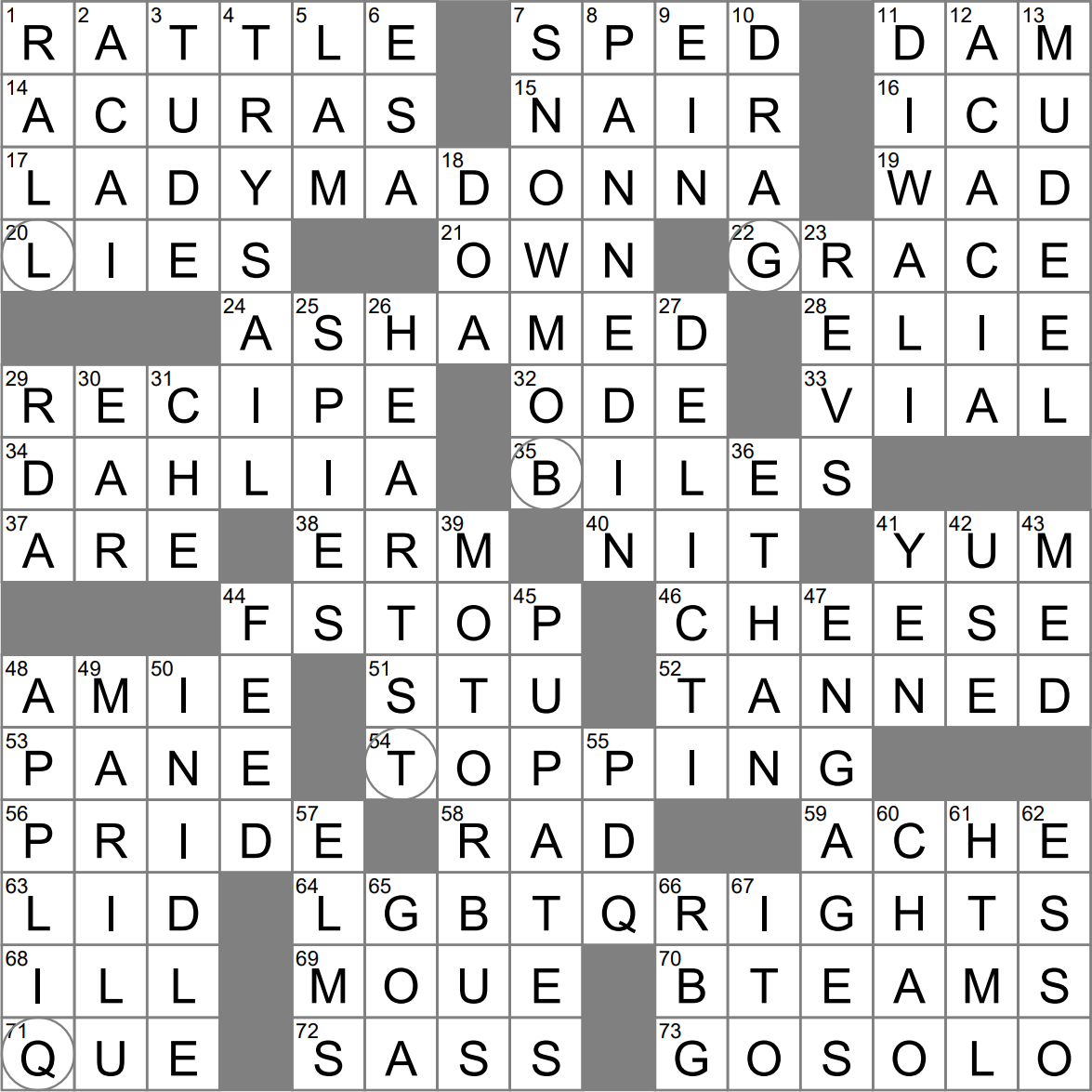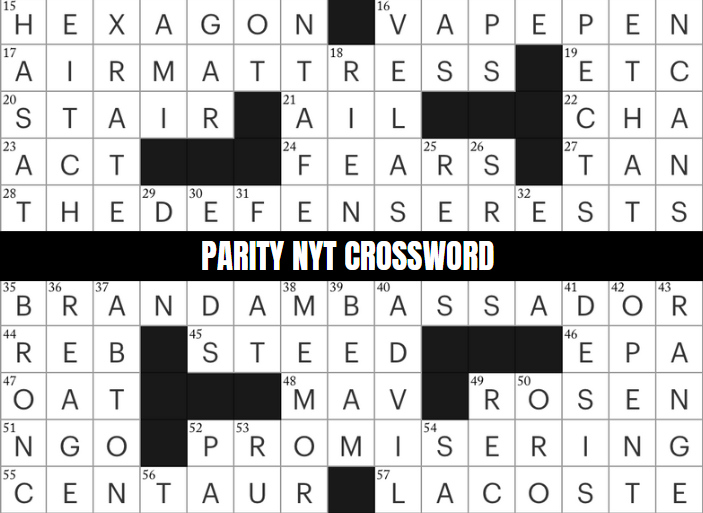The Parity NYT Crossword: A Comprehensive Guide
Crossword puzzles have long been a beloved pastime for many, offering a delightful mix of challenge and entertainment. Among the most popular sources of crossword puzzles is The New York Times (NYT), known for its clever clues and engaging themes.
In this article, we will explore the “parity NYT crossword,” delving into its significance, strategies for solving, and much more, while optimizing the content for search engines.
Understanding the Concept of “Parity” in Crossword Puzzles
The term “parity” in the context of crossword puzzles often refers to balance or equality. In many puzzles, especially those found in the NYT, clues may play on words that relate to numerical or thematic parity, making them intriguing and intellectually stimulating.

Also Read: Everything You Need to Know About “Kimbsxo”: The Ultimate Style and Beauty Guide
What is Parity?
In mathematical and logical contexts, parity refers to the evenness or oddness of a number. However, in the realm of crossword puzzles, the term is more nuanced. It can signify balance, equality, or equivalence between elements.
Importance of Parity in Crosswords:
- Thematic Clues: Many clues utilize the concept of parity to create clever wordplay, encouraging solvers to think outside the box.
- Word Relationships: Understanding parity can enhance your ability to recognize patterns and relationships between words in the puzzle.
The NYT Crossword: A Legacy of Wit and Challenge
The New York Times Crossword is one of the most renowned crossword puzzles globally, attracting millions of solvers. It was first introduced in 1942 and has since become a daily staple for puzzle enthusiasts.
Key Features of the NYT Crossword:
- Daily Difficulty Levels:
- The NYT crossword offers varying difficulty levels throughout the week, starting from easy on Monday to increasingly challenging puzzles by Saturday, culminating in the notoriously difficult Sunday edition.
- Clever Cluing:
- NYT puzzles are famous for their witty and sometimes deceptive clues. The use of puns, homophones, and lateral thinking is commonplace, making each puzzle a unique challenge.
- Cultural References:
- The puzzles often incorporate current events, pop culture, and historical references, adding layers of complexity and making them relevant to contemporary readers.
Exploring the “Parity NYT Crossword”
The “parity NYT crossword” typically features clues that incorporate themes of equality or balance, leading solvers to think about connections between words, phrases, or concepts.
Example Clue: “Small change in party parity?”
In this instance, the clue could be referring to a shift or slight adjustment in the state of balance within a group or organization, often hinting at political contexts.
Possible Solutions:
- TWEAK: This could imply a small change or adjustment in a policy or situation.
- SWITCH: This suggests a change in positions or roles, reflecting a shift in balance.
- FLIP: Similar to switch, it indicates a sudden or minor change in circumstances or opinions.

Also Read: Everything You Need to Know About “Kimbsxo”: The Ultimate Style and Beauty Guide
Thematic Interpretation:
The clue could also reflect broader themes in politics, social movements, or other group dynamics where changes in balance (or parity) are significant. Understanding these nuances can enhance your solving experience and comprehension of the puzzle’s deeper meanings.
Strategies for Solving the Parity NYT Crossword
To master the art of solving the “parity NYT crossword,” one must adopt effective strategies. Here are several tips to improve your crossword-solving skills:
1. Familiarize Yourself with Common Clue Types
Understanding the different types of clues can significantly impact your solving speed and accuracy. Here are some common clue formats:
- Straightforward Definitions: Clues that directly define the answer.
- Wordplay: Clues that use puns, anagrams, or homophones.
- Fill-in-the-Blank: Clues that present a sentence with a missing word or phrase.
2. Build Your Vocabulary
A strong vocabulary is crucial for solving crosswords. Regularly engaging with various puzzles can help expand your word knowledge, especially obscure terms and phrases that may appear in the NYT crossword.
3. Utilize Cross-Referencing
Cross-referencing answers can provide vital clues. If you’re uncertain about one answer, solving intersecting clues can give hints to confirm or eliminate possibilities.
4. Take Breaks
If you find yourself stuck on a puzzle, stepping away for a moment can help refresh your perspective. You may return with a new insight or idea that can lead you to the answer.
5. Use Online Resources
There are numerous online communities and resources dedicated to crossword solving. Websites, forums, and social media groups often provide hints and strategies that can enhance your solving experience.

Also Read: Everything You Need to Know About “Kimbsxo”: The Ultimate Style and Beauty Guide
Analyzing the Clue: “Small Change in Party Parity?”
To dissect the clue “Small change in party parity?”, let’s consider the linguistic and contextual elements:
Language Breakdown
- “Small change”: This phrase indicates a minor adjustment, which could imply a range of answers that suggest tweaking or slight modifications.
- “Party parity”: This could refer to balance within a political party or social group, indicating a need for solutions that reflect that balance.
Contextual Significance
The clue can be interpreted in a variety of ways, particularly in relation to contemporary political discussions. The dynamic of parties in politics is often subject to shifts in parity, making this clue not just a puzzle but also a reflection of real-world events.
Additional Possible Answers
Along with the previously mentioned answers (TWEAK, SWITCH, FLIP), other potential responses could include:
- BALANCE: Implies achieving equality or equilibrium.
- NUDGE: Suggests a slight adjustment or persuasion towards a different position.
- ADJUST: Indicates making a change for improvement or correction.
Also Read: Everything You Need to Know About “Kimbsxo”: The Ultimate Style and Beauty Guide
The Role of Parity in Political Contexts
Understanding the broader implications of the “parity NYT crossword” clue can shed light on the dynamics of contemporary politics.
Political Parity
Political parity refers to the concept of equal representation among different groups, often focusing on issues like gender equality, party representation, or even the balance of power in government.
Importance in Governance:
- Fair Representation: Achieving parity ensures that all voices are heard and considered in the decision-making process.
- Policy Balance: Equal representation leads to more balanced policy-making, reflecting diverse perspectives.
Examples in Recent Politics
- Gender Parity: Many political movements have aimed for gender parity in legislative bodies, advocating for equal representation of women.
- Bipartisanship: In many democratic systems, achieving parity between political parties is crucial for balanced governance and effective policy-making.

Enhancing Your Crossword Solving Skills
To delve deeper into solving the “parity NYT crossword,” consider implementing these advanced strategies:
1. Analyze Previous Puzzles
Reflect on past puzzles you’ve completed, especially those with similar themes. Understanding how clues were phrased and solved can improve your pattern recognition.
2. Engage in Collaborative Solving
Solving puzzles with friends or joining crossword clubs can offer fresh perspectives. Collaborating allows for discussion about clues and potential answers, enhancing collective understanding.
3. Keep a Crossword Journal
Maintaining a journal where you document challenging clues and their solutions can serve as a valuable resource for future puzzles. Over time, you’ll build a reference that highlights trends and patterns.
4. Explore Diverse Sources
Engaging with crosswords beyond the NYT can expand your exposure to different styles and clue formats. Consider puzzles from various newspapers, magazines, or online platforms.
Also Read: Everything You Need to Know About “Kimbsxo”: The Ultimate Style and Beauty Guide
FAQs about the Parity NYT Crossword
1. What is the best way to approach a NYT crossword for beginners?
For beginners, it’s advisable to start with the Monday puzzles, as they are generally easier. Familiarizing yourself with common clues and regularly practicing will build your confidence and skills over time.
2. How often does the NYT crossword change?
The NYT crossword is published daily, with new puzzles available each day of the week, varying in difficulty. Sundays feature the largest puzzles, typically presenting the most significant challenge.
3. Can I find archived NYT crosswords online?
Yes, The New York Times maintains an archive of past crosswords on their website, allowing subscribers to access previous puzzles and practice solving them.
4. What are some common themes in the NYT crossword?
Common themes often include wordplay, homophones, current events, pop culture references, and sometimes even seasonal or holiday-related clues.
5. Is it possible to solve NYT crosswords without any prior experience?
While some experience can be helpful, it’s entirely possible for newcomers to solve NYT crosswords with dedication and practice. Over time, you’ll develop the skills and knowledge necessary to tackle even the most challenging clues.

Also Read: Everything You Need to Know About “Kimbsxo”: The Ultimate Style and Beauty Guide
Conclusion
The “parity NYT crossword“ represents not just a fun challenge but also a rich tapestry of language, culture, and societal themes. By understanding the concept of parity, honing your solving strategies, and embracing the dynamic nature of the NYT crossword, you can enhance your puzzle-solving skills while enjoying the intricacies of this timeless pastime. Whether you’re a seasoned solver or a newcomer, the journey through the world of crosswords promises to be both stimulating and rewarding. So grab your pencil, embrace the challenge, and enjoy the delightful world of the NYT crossword!






